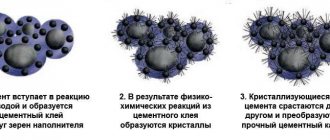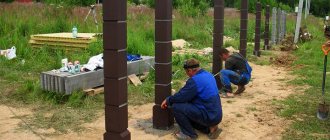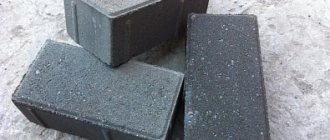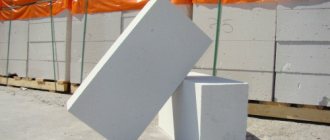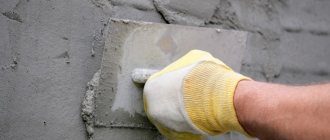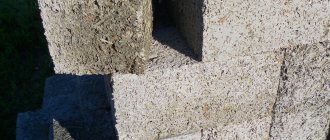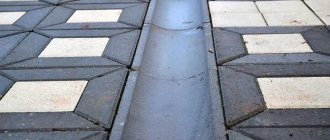Concrete is the main material without which it is impossible to imagine any construction project, from apartment renovation to the construction of factory buildings.
The properties of concrete are determined by its composition, the ratio of the number of components, and the mixing method. It would seem that there is something special about mixing cement mortar: pour it in, mix it and you’re done! However, it's not that simple. This matter also has its own rules, compliance with which will not only allow you to obtain high-quality material, but also save energy and time.
What types of cement are there?
On the packaging of cement there are designations, for example: m300, m500, m500 d0.
Assignment of a cement grade is carried out through laboratory tests of material samples for strength. After hardening, rectangular blanks made from a cement-sand mixture and water are subjected to bending and compression tests.
Marking “m” is a characteristic of the compressive strength of the sample. The cement cube is placed under a press and gradually compressed until completely destroyed. The compressive strength is calculated as the arithmetic mean of 4 samples with the best performance out of 6 taken.
Thus, grade M500 indicates the ability of cement to withstand a load of 500 kg/cm3, cement M400 - a load of 400 kg/cm3, and so on. The most durable cement grades M600 and M700 are mainly used in military construction.
Marking in the form of the letter “d” characterizes the percentage of optional additives in relation to pure clinker in a batch of cement.
Thanks to additives, cement acquires additional specific properties: frost resistance, hydrophobicity, rapid hardening, resistance to salt water and corrosion. The designation m500 d20 indicates that this batch of cement contains 20% additives. And the m400d0 marking means that there are no optional additives. There is a group of slag cements, another name is slag Portland cement, the content of additives in which is over 20%. There are additional abbreviations, for example, m500-d20-ss. The last two letters indicate the properties of cement imparted to it by additives.
The most common designations for cement
- PC is ordinary Portland cement.
- ShPC is Portland slag cement containing more than 20% additive compared to the clinker component.
- BC – white cement for finishing.
- WRC is a waterproof expanding cement. Used for sealing seams in hydraulic structures. Characterized by fast setting (4-10 minutes).
- N – standardized cement. Contains clinker of strictly standardized composition.
- PL – plasticized cement with high frost resistance.
- GF – hydrophobic cement. It does not absorb water within 5 minutes, is easy to transport, and is characterized by good plasticity and frost resistance.
- SS – sulfate-resistant cement. It is used for the construction of hydraulic structures in aggressive water-salt environments containing sulfate compounds.
- B – fast-hardening cement. Used for urgent repairs.
How is white cement without a sand component used?
Non-professionals have to lay white cement much less often. A type of bulk building material in its pure state is unique in its characteristics and has far from the only positive property. It can also be applied without the sand component if it is necessary to create a perfectly white coating layer. The rules by which cooking is carried out are still the same. The author of a sculpture or landscape element determines the proportions himself to obtain the optimal structure or product.
How to mix cement mortar
In order to mix cement efficiently, you first need to decide on its recipe: what components to use, in what proportions. The composition and ratio of the components of the cement mortar depend on the type of construction work and the climatic conditions of the area. The technology for mixing cement mortar at positive and negative temperatures is different.
When making concrete, the marking of cement, the type of sand and the quality of water are important.
Failure to follow the recipe and mixing rules can result in the formation of cracks on walls and brickwork.
How to choose the right components for cement mortar
Recently, many types of cement mixtures with various fillers have appeared to enhance one or another function of concrete: mechanical strength, thermal insulation, sound insulation, waterproofing. The basic materials of concrete mortar are cement, sand and water.
There are different grades of cement: m100, m200, m300 and others. The higher the number, the more sand will be required when mixing the concrete solution. For example, to make concrete from M100 cement, you will need a ratio of cement to sand of 1/1, and for the M400 grade - ¼.
Which sand to choose for cement mortar
To obtain an even, beautiful seam during face masonry, it is better to use river or quarry sand without clay, sifted to remove debris and stones. Clay does not mix well with cement and, if it gets in from the outside of a masonry joint, it will eventually form a hole. For laying under plaster, you can add any sand to the solution. Clean sand is whiter, and with clay it is yellow.
What kind of water can be used for mixing cement mortar?
When constructing major construction projects and load-bearing structures, it is not recommended to use rainwater or water containing oils for mixing cement. In domestic conditions and small-scale construction, cement mortar is made from any water.
Preparation of materials for mixing cement mortar
To obtain high-quality cement mortar, it is important to properly prepare the starting materials. Preparatory activities include:
- Pre-washing of crushed stone to remove adhering dirt and debris.
- Carefully sift and, if possible, wash the sand to remove stones, clay and dust.
How to prepare ballast for cement mortar
Before mixing the cement mortar, gravel and sand are sifted to prevent the ingress of foreign impurities and to sort the components by size. Crushed stone is passed three times through a sieve with cells of different sizes. First - 20x20 mm, then - 10x10 mm, and the third time - 5 mm. Screenings of 20-40 mm belong to the first fraction. The second fraction is grains of 10-20 mm. Third - 6-10 mm.
To prepare the cement mortar, use 30% of the ballast of each fraction and mix thoroughly.
Failure to comply with the proportions of cement mortar components negatively affects the quality of concrete. With a lack of cement, strength, frost and moisture resistance decreases. Excess water leads to corrosion of the reinforcement inside the concrete structure. If there is not enough water, the plasticity of the solution deteriorates, which makes it difficult to work with and will require additional compaction of the concrete. The optimal water consumption per 1 cubic meter of concrete is 150-170 liters.
What are the methods for mixing cement mortar?
After preparing the components, begin kneading.
There are 2 mixing methods: using a concrete mixer and manually.
Mechanized method
The advantages of using a concrete mixer are obvious: mixing the cement solution is faster and physically much easier.
The use of a concrete mixer is especially justified for large construction volumes. It is not necessary to buy a concrete mixer; you can rent one. In addition to the unit itself, you will need a bucket and a shovel. The machine will mix the concrete itself; the user only needs to follow the mixing sequence.
Procedure:
- The tilt of the concrete mixer bowl is set at an angle of 45 degrees.
- First, water is poured into the concrete mixer. The volume of water is taken taking into account the amount of cement. For 1 bucket of cement there is approximately the same amount of water. Water is added gradually as mixing progresses. The amount of water also depends on the weather. In the rain - less water, in the heat - more.
- Then pour half the norm of sand.
- Then add all the cement, mix everything for 2-3 minutes and pour out the remaining sand.
- The desired consistency of the mixture is adjusted by adding water little by little and stirring for 3-5 minutes.
Manual method
A small amount of concrete can also be mixed by hand. For this you will need: a trough, a bucket and a shovel. It is convenient to mix cement mortar on a sheet of linoleum or vinyl for advertising banners.
In construction practice, two types of manual kneading are used.
Option #1.
The calculated volume of water is poured into the trough and a measured amount of cement is added. Stir. The result is a liquid cement mixture. This method is convenient because the solution is easy to mix until the cement lumps completely disappear. Then add the specified amount of sand and mix well until a homogeneous consistency is obtained.
Option number 2.
Sand and cement are poured into the container in specified proportions and mixed thoroughly with a shovel.
In the center of the dry mixture, make a small depression in the form of a funnel, into which a measured portion of water is poured, less than the calculated amount.
The cement mortar is mixed from the edges to the center of the funnel with a shovel, moving the dry cement-ballast mixture and combining it with water. To obtain homogeneous concrete, it is important to reach the bottom of the container when mixing. Such mixing requires significant physical effort; it is used in cases where it is not known exactly how many parts of water will be needed for the desired consistency of the cement mortar. If you measure the required amount of water, then the next portions of the cement mortar are mixed using the easier, first method.
To obtain an elastic mixture, add 50-100 ml of detergent or liquid soap to the water. Mixing cement mortar at sub-zero temperatures has its own characteristics. In such conditions, it is recommended to add a special frost-resistant potash mixture.
With any mixing method, manual or mechanized, the quality of concrete depends on maintaining the proportions of all components and the sequence of technological actions.
Preparing for work
To obtain a good cement mortar, you need to properly prepare the components. The following activities will be required:
Fillers for cement mortar.
- the crushed stone must be thoroughly washed so that no debris or dirt remains in it;
- the sand is sifted and, if possible, washed - this helps to remove pebbles, dust, and inclusions of clay from it.
Before you start mixing the solution, crushed stone should be passed through a sieve with cells of different sizes three times. The dimensions should be: 20X20 mm, 10X10 mm, 5X5 mm. Screened after the largest of the listed cell sizes is considered the first fraction, then comes the second fraction and the third, which is grains of 5-10 mm.
If you do not carefully observe the proportions of the components added to the solution, you will not be able to achieve good quality concrete.
If you add little cement, the composition will have reduced strength, moisture resistance, and frost resistance. If there is more water than necessary inside a concrete structure, the reinforcement may begin to rust. With less water than the recipe suggests, the plasticity of the composition deteriorates. Working with such a solution is inconvenient and difficult, and the concrete will need to be further compacted. There should be 150-170 liters of water per 1m³ of solution.
How to prepare cement mortar for building a foundation
Concrete mortar for pouring the foundation is mixed as follows:
Materials and their proportions
- cement m500 – 1 part,
- sand - 3 parts,
- crushed stone 4 parts,
- water - 1 part.
For example, one part is one bucket.
- Step 1. Pour 2 buckets of water into a wide container. Depending on the moisture level of the sand, you may have to add additional water.
- Step2. Pour 2 buckets of cement (without the top) into the water. A 50 kg bag holds 4 buckets of cement.
- When pouring cement, continuously stir the mixture until a homogeneous liquid mass is obtained.
- Step3. Continuing to stir, add 6 buckets of sand and bring the mixture to a homogeneous consistency.
- Step4. Pour 8 buckets of crushed stone into the cement-sand mortar.
To facilitate the work, crushed stone should be scattered evenly throughout the entire container in which the batch is made. The resulting concrete solution is mixed after each ballast bucket.
After filling the last, eighth portion of crushed stone and thoroughly mixing, the concrete solution is ready to be poured into the formwork.
You can mix the concrete mixture with a shovel, garden hoe or flat cutter.
How to mix cement mortar for brick or stone masonry
The preparation of this type of solution is characterized by less water: one and a half buckets of water instead of two. The higher the water content, the thinner the solution and the slower it dries. As part of the mortar for brickwork, cement and sand are used in a ratio of 1:5 if the work is carried out above ground level and in a ratio of 1:3 if the masonry is buried below ground level.
How to calculate the consumption of cement mortar for brickwork
The consumption of mortar for all types of brickwork is almost the same.
To make one cube of cement mortar, you will need 8 bags of cement of 50 kg each and mixed with sand in a ratio of 1:4. The consumption of cement mortar per 1 m3 of brickwork on a solid wall is approximately 0.25–0.30 m3.
Mixing proportions
The ratio of elements in the cement mortar depends on the area of application of the mixture and the brand of concrete. For example, if you need to get M100 cement mortar from M400 concrete, the ratio of cement to sand will be 1:4. Thus, it is easy to calculate what ratio is needed to obtain the desired grade from any concrete.
How to make cement mortar for different types of work (cement: sand):
- Plaster: 1:5 with the addition of one part of lime;
- Floor screed: 1:4 for brand M500, 1:3 for brand M400;
- Brickwork: 1:5 – M3, 1:4 – M5, 1:3 – M8. In this case, the brand of the finished mortar must correspond to the brand of brick.
The volume of water for preparing the liquid solution should not exceed 60% of the total volume. Usually it is 1-2 parts in proportion.
During the mixing process, the cement mortar sometimes becomes too liquid. Set aside some of the dry mixture so you can add it if necessary.
How to prepare a small amount of cement mortar at home
There are situations in the household when minor construction repairs using cement are required: repairing cracks in the walls, unevenness on the floor.
In such cases, a sand to cement ratio of 3:1 is most often used to prepare the mortar.
A small amount of cement mortar is mixed in a wide plastic or metal container. First, three parts of sand are poured into it, then one part of cement is added. Use only fresh and dry cement, without hard lumps. If the sand contains stones, lumps of clay, or earth, then it is first sifted.
Mix the cement and sand well with a spatula. Then water is poured into the container in the same volume as cement. The components are mixed until a homogeneous mixture is obtained. Do not mix the solution too thin. A properly prepared solution adheres well to a spatula or trowel. The prepared solution must be used within two hours. Therefore, they knead such a volume so that they have time to use it up during this time.
For interior work, lime mortar is often used instead of water when mixing concrete.
Pouring and leveling the floor
To make the floor perfectly flat, it is filled with cement mortar. This is a very important part of the work and it must be done correctly. The floor screed is laid on gravel or crushed stone.
Calculation for screed
For floor screed, cement mortars of grades M150 or M200 are needed. You can buy ready-made mixtures with plasticizers, but with this option the screed will be much more expensive.
To prepare a mortar of grade M150, you need to take one part of M 400 cement and three parts of sand. To prepare a solution of M200 sand, you can take two parts.
If the screed does not hide communications, its height can be made at 3-5 centimeters. To calculate how much mortar is required, you need to multiply the height of the screed layer by the surface area.
Which cement is best for screed
Portland cement M 400 is most often used for floor screeding. It has a good tensile strength, so a floor filled with this cement can withstand heavy loads.
How to dilute cement for flooring
To screed the floor, a high-quality mixture is required. Unsifted river sand should not be used. The mixture must be mixed thoroughly. It is better to do this with a construction mixer, since the uniformity of the floor screed solution is very important.
False seizure
Nowadays, many cement mixtures with plasticizing additives have appeared. Solutions made from them are much more convenient to use, but they slow down setting. In the construction industry, this phenomenon is called “false setting”, since it is followed by a long induction period during which strength is not gained. False setting is an undesirable phenomenon, as it interferes with the quality compaction of concrete.
Types of false apprehension, its causes and methods of elimination:
How long does it take for cement to harden?
The cement hardens during the first three days, but after that it must be allowed to stand and gain strength. Concrete gains its full declared strength only after a month, if the air temperature during the day is not lower than ten degrees C.
When screeding a floor, the full setting varies depending on its composition and thickness. The higher the screed height, the longer it takes to dry.
How to prepare cement mortar for floor screed
To prepare the solution you will need building materials:
- Sand. Not too wet, sifted and cleared of stones and debris.
- Cement m400. Be sure to be fresh, as the quality decreases during storage.
- Plasticizer. Designed to give the mixture elasticity, facilitate the installation process and prevent the appearance of cracks in the screed.
- Fiber. Polypropylene fiber that prevents cracks.
When making a floor screed solution, liquid and dry ingredients are mixed separately.
First, the dry ingredients are poured and thoroughly mixed: sand, cement, fiber. The proportion of sand and cement is 3:1. Fiber is added in small bunches to avoid lumps.
If the sand content is higher than normal, the finished screed will begin to crumble and the density of the coating will be uneven.
The plasticizer is poured into another container, then water is added and mixed thoroughly. The amount of plasticizer is taken at the rate of approximately 190 g per 50 kg of cement. The volume of water is 1/3 of the mass of cement minus the volume of plasticizer.
After this, they begin to combine the liquid and dry parts: gradually pour the dry mixture into a container with water, stirring continuously so that there are no lumps.
It is more difficult to lay a screed with a mortar that is too viscous, but cracks will not form. Liquid screed is easier to work with, but often cracks and requires wetting the surface up to several times a day to dry all layers evenly.
It is easier and better to stir the solution not by hand, but using a drill or a construction mixer with a special attachment. Mixing time is at least five minutes. The finished solution has the appearance of a viscous, homogeneous, plastic mass. After a 2-3 minute pause, the solution is stirred again for 2 minutes.
The finished solution is suitable for use for no more than one and a half hours, after which it hardens. Therefore, the entire solution is used at once. Re-mixing the cement mortar is not possible.
Recommended mortar proportions for plaster mixtures
When carrying out internal work, you will need cement from M150; for cladding facades you need a higher grade - M300. The proven proportions for plastering walls are 1:3. In this case, it is recommended to mix sand with cement before mixing and gradually dilute the resulting dry mixture with water. The result is a homogeneous mass that does not flow off the trowel when tilted at 45°; the W/C ratio is chosen to be ?1. To increase plasticity, lime can be diluted and quenched in added water (0.2–0.3 parts of the amount of cement); such a solution is applied more thinly. To give the plaster thermal insulation properties, sand is partially replaced with perlite.
For plaster and floor screed
When thinking about how to make cement mortar for screed and plaster, it is worth remembering that we are talking about different properties. Floors are filled with relatively liquid solutions, while for plastering thick mixtures of pure sand, cement and water are prepared. The thickness of the plaster mixture depends on many factors.
Most often, in the preparation of plaster, the following proportion is used: 1 part cement and 5 parts sand with a sufficient volume of water to obtain the desired consistency. More durable mixtures are prepared for screeds, since they must withstand certain loads. Here you will need a minimum grade of TsPS 150, but it is better to make a cement-sand mortar M200 and higher. Materials must demonstrate a threshold strength of at least 10 MPa.
To understand how to properly dilute cement, you need to take into account the work and operating conditions. So, if the mixture is used to mask various utilities, it may be thicker. But to level the surface and strengthen the floor, liquid DSP is used. The thicker the layer, the higher the grade of concrete should be.
When a cement-sand mixture is used, the consumption of materials plays a major role and it is important to calculate it before starting work. Calculations are based on the cubic capacity of the site/room. Measurements are taken with a tape measure, the width is multiplied by the length and the area is obtained. Next, take the depth of the layer and calculate how much mixture needs to be poured. On average, for a screed 10 centimeters thick you need 50 kilograms of M400 solution per square meter.
To perform individual calculations, the values are converted to cubic capacity to calculate the consumption of cement-sand mixture per 1 m2.
Performing calculations:
- For a room with an area of 100 square meters and pouring a screed 10 centimeters (0.1 meters) deep, you need 10 m3 of solution. On average, about 555-713 mixtures are consumed per 1 m3 (exact data can be found in the instructions on the packaging) - which means that for 10 cubic meters the figure needs to be multiplied by 10. The weight depends on the brand of cement - for a mixture based on M400, the weight is calculated to be within 700 kilograms , for M100 – already 500-600 kilograms.
- The consumption of CPS per 1 m2 is almost the same for preparing a solution from a ready-made mixture or individual components. So, if we are talking about the finished mixture, then it contains about 1.4 kilograms (specific gravity) in one liter. Therefore, to fill 10 cubic meters of screed you will need a dry mixture: (10 m3x650kg) x 1.4 = 9100 kilograms. Thus, to fill 10 m3 of mixture you need 9100 kilograms of dry powder or 6500 liters.
What should the consistency of concrete be?
The density of the cement mixture is determined by the nature of the work performed. For brickwork it is thicker, for plaster it is more liquid. In most cases, a creamy consistency is considered optimal.
There is a trick to check the correct consistency of concrete. Using a shovel blade, cut a square on the surface of the concrete mortar and check the condition of its edges. If the mixture crumbles, there is not enough water. Edges that are too wet or even filled with water indicate excess moisture. In this case, you need to mix a little cement.
Safety precautions when preparing the solution
Cement is a harmful substance that has a chemical composition that negatively affects the human body. Therefore, in order to avoid various health problems, it is necessary to follow safety rules.
When working, use respirators or special masks that protect the respiratory system and eyes from cement dust. If a respirator is used, goggles must be worn. Cement can corrode the skin or dry it out, in some cases allergies occur, so you need to protect your hands with gloves. Also, bags of cement have an impressive weight; if you need to lift it, emphasis is placed on your legs so as not to break your back.
If the noise of a concrete mixer irritates you, you can use headphones that protect against loud noise. You cannot do without cement during construction work, but you should remember about safety measures. When the work is done correctly and all proportions are observed, the result is a high-quality composition that can be used for laying bricks, creating a foundation, plastering or screeding. If the proportions or sequence of work are not followed, this can lead to a number of problems, for example, the appearance of cracks and destruction of the mortar.
Safety rules when working with cement
In order to avoid injury and harm to health when mixing cement mortar, it is important to strictly follow the rules of personal safety:
- Use special glasses to protect your eyes from cement dust.
- Wear gloves to prevent cement from coming into contact with your skin.
- Protect your respiratory system with a respirator or petal mask.
- Avoid lifting heavy objects; if necessary, you should lift the load with your knees slightly bent, using the force of straightening your legs, and not straining your back muscles.
- When using a concrete mixer, wear noise-protective headphones.
Water with neutral ph
Rusty and hard water reduces the frost resistance and heat resistance of the mixture. Metal salts, penetrating into the solution, destroy the crystals of cement stone and provoke cracking of the canvas. Only clean water with a neutral pH is suitable for mixing cement.
A high-quality sealer should not show the following signs of contamination:
- strong chemical/organic odor;
- sediment, flakes, scale;
- brown, earthy, gray shade;
- impurities of earth, clay, and other components;
- the presence of foreign bodies - roots, leaves, construction waste.
Process water from a standpipe, well, or river is suitable for preparing cement mortar. If necessary, the liquid is purified using homemade or household filters, as well as chemicals to neutralize metal salts.
Who is the most important person at a construction site?
Cement mortar is the basis of all construction work. There is no substitute for this material. Every year new cement compositions of improved quality appear. For large-scale construction, the solution is produced in special concrete plants using high-tech equipment. In private construction, it is quite possible to prepare cement mortar yourself: either manually or using a concrete mixer or construction mixer. If you follow simple rules for selecting and preparing the components of the solution and mixing them, you will get a strong and durable concrete coating.
Sifting sand
It is worth considering that the fewer impurities and large particles in the sand, the better and smoother the surface will be (when pouring). For sifting, you can use a sieve, colander or fine mesh, or drill holes in the bucket with a thin drill, as my neighbor in the garage did. I had to sift sand in large quantities, so I put together a frame of wood one and a half by one and a half meters and nailed a metal mesh. All that was left was to throw sand on it and shake it over the edge. Fine-grained sand for cement mortar is ready. You can find sand in quarries, on a river, or just buy it in a store.



